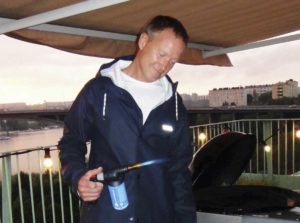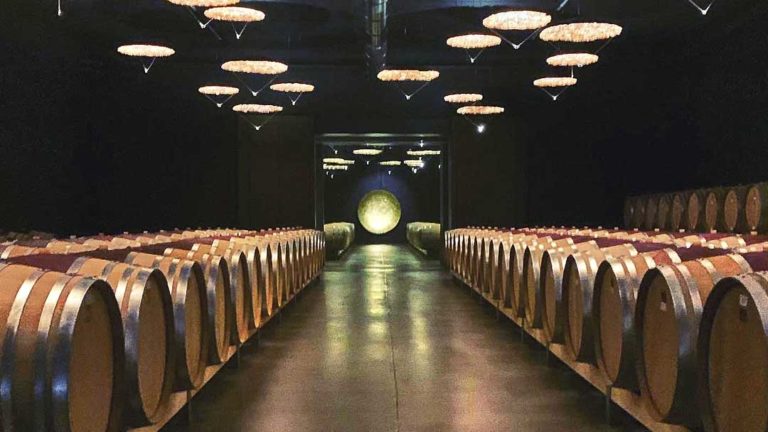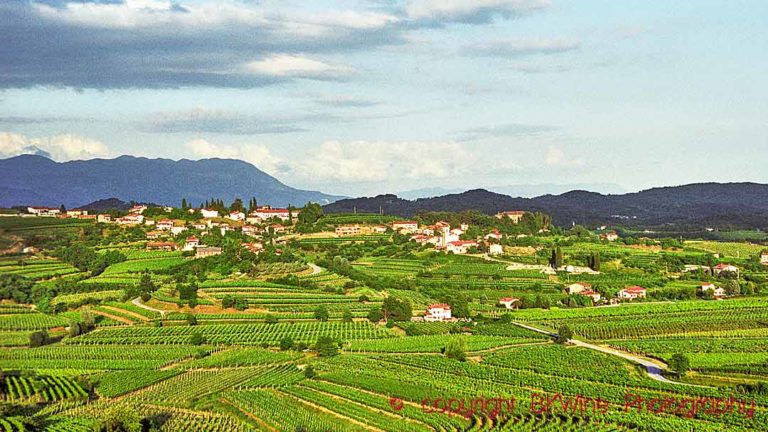Everyone loves influencers. Before you let your irritation dangerously increase your heart rate, look around and list your own five most influential influencers. Well, you can’t think of any. But then raise your gaze a bit above the peach-skinned youngsters who hunt for money through posts about make-up and fashion.
Madeleine Stenwreth is a razor-sharp influencer, although the word was hardly invented when she managed to add the coveted title of Master of Wine to her name. In addition, she has passed fifty, which means that the title “influencer” reasonably has difficulty sticking to the business card. Three years ago, she was moderator when 15 producers from Valtellina had their wines showcased. Read more about this here: Valtellina – in the shadow of Piedmont, the sun is shining.
Some of the producers were present and were given the opportunity to introduce their wines in person. The hall was packed and pretty much every wine writer was there; the interest in Valtellina was palpable. The pandemic put a stop to most of it but now, three years later, the car rolled down to this northern and steeply hilly district of Italy. The “influencer” had succeeded in her mission.
Preparing for the drive down, I reviewed old notes from the tasting and, as far as my old scribbles could be deciphered, I found two favourites. Sandro Fay and Le Strie. Favourites from the tasting can in many ways be an incorrect statement because the tasting included many completely different characters of wine. The first flight of five wines were relatively light, vital and fresh wines. The following flight gave clear signals of nebbiolo with a rather strict stance and pure clarity. The closing flight was a carpet bomb of powerful liquids that could in no way be linked to the first five wines. Regardless of which style of wine you prefer, the majority of the wines were of a high standard combined with a moderate price tag. Add to that seductively beautiful images of terraced plantations and an undulating landscape. Then and there I realized that the area is a must-visit.
Valtellina is a relatively small region. A narrow strip of land that stretches 45 km from west to east, just a few kilometres from the Swiss border. In the valley, all 820 cultivated hectares are on the south-facing slope. The vines grow from three hundred meters altitude up to about eight hundred meters. The area is distributed among very many small and very few large producers. That fewer than ten of the region’s 900 growers own more than 3 ha says something. We can a bit inaccurately specify nebbiolo as a character grape, but the diversity is great and some other varieties are newly planted, according to the producer’s own desires.
Sandro Fay, for example, has chosen chardonnay on his most recently planted plot at an altitude of eight hundred meters. The region has the second largest areas of nebbiolo in Italy, or chiavennasca as the grape is known locally. The producers highlight the clear difference in the different growing conditions, but at the same time point out that the winemaker’s own work controls much of the wine’s character.
Le Strie
Let’s take a look at the two producers I mentioned, which I visited in June 2022. Sandro Fay and Le Strie.
Stefano Vincentini, who is the sole owner of Azienda Agricola Le Strie, started his production as recently as 2002. The production facility is housed in an old stone house in Ponte in Valtellina. The old vaults are no bigger than a generous garage. We tasted the wines in the building next door, where an old dungeon from the 17th century has been furnished with simple tables and chairs. The small hatchway in the door was still there in the solid wooden door. The hatch that opened when a piece of dry and wretched bread was served as supper to the emaciated guest shackled inside the cave. The gods should know that we are infinitely grateful that we were there on a completely different matter.
With nine thousand bottles produced per year, we can rightly call it a small producer “I am busy from morning to night tending to my vines and have no thought of growing from my two hectares”, says Stefano. “I’m happy with my size and would rather spend my time improving the winery,” he adds. Le Strie has some of its vines clinging to one of the most difficult locations in the Valtellina. In 2018, they had had enough of pushing heavy baskets down the paths and tried to solve the task with a helicopter.
Copyright: Le Strie, used with permission
An efficient way where the container takes half a ton with each lift. One fact that is sometimes mentions is that the plantations in Valtellina are distributed over nearly 20,000 terraces of varying sizes. You may wonder who did the counting, but if you walk around the area, you quickly realize what a horrible job it is to get the grapes down to the production facilities.
Sandro Fay
When we visited Sandro Fay (Societá Agricola Fay) the temperature reached 37 degrees C. Elena Fay waved happily as we turned into the yard, she pulled her shirt in and out perhaps more to symbolize the heat than to really get gusts of wind to cool her body. “Oh, hello, welcome,” she said cheerfully. “The vineyards or the tasting first?” asked Elena. We looked at each other with hesitation but the missing answer was replaced by. “Esh, get in the car and we’ll take the vineyards first,” Elena said briskly. “It’s so much easier to understand the wines when you’ve seen the vineyards,” she added.
The car worked its way up narrow, steep roads with bends sometimes so sharp that you had to stop, reverse, and make another try to get further. The story-telling was intense and there was an obvious benefit in previous knowledge of soil, direction and winemaking in order to interpret the flow of information.
The Fay family started the business in 1973 and today manage 15 ha. As a quick summary, the impression was that Sandro Fay uses knowledge of history and tradition for good winemaking, supplemented by the will and desire to explore and develop. Like, for example, their newly planted vines with chardonnay where another owner may have chosen to let completely different vines grow, traditional for the district.
During the tasting, it was easy to like all the cuvées. If Le Strie gave a warm and rustic impression, Sandro Fay was a display of stylish, rigorous and clean wines. Both good but in different ways. Il Glicine 2018 from 100% nebbiolo gives enormously lovely and grape-typical signals. So easy to like with its nice acidity, smooth tannins and excellent length. Definitely very drinkable now. Ca Morei 2018, on the other hand, was somewhat harder and tougher than Il Glicine (grown at a higher altitude) but overall a lovely and long wine, possibly with a footnote that it can keep well for a couple of years.
Finally, their sforzato, also called sfursat, the Sforzato Ronco del Picchio was served, where the taste buds in a pure defence mechanism prepared for a heavy and massive attack. Instead, a dry wine with a firm backbone and a lot of attitude rolled into the mouth. Of the expected residual sweetness, and for some palates clumsiness, there was not a trace. The experience was instead of a wine that was dry, powerful, rich and full of facets. 15.5% alcohol! When we tried the sforzato three years ago (2019) at the tasting I mentioned above, my immediate thought was that this is for the guys with chest hair. But Sandro Fay’s version is so much prettier that I like to broaden the audience a bit. Perhaps I should add that sforzato is produced from grapes that have been allowed to dry for a period of time, between 30 and 100 days. All producers emphasized the importance that none of the grapes in the basket be damaged before drying and some stated emphatically that a human hand never touched the grape more than once. Contrast the latter with grapes crushed by human feet. The grapes, handled with care, must be 100% nebbiolo. During the drying process, they lose 20-40% of their weight depending on the producer (water evaporation).
Both Le Strie and Sandro Fay rely on spontaneous fermentation for all cuvées except for sforzato, where it is even dangerous to take a chance on getting a controlled fermentation without added yeast. You can draw parallels to amarone in terms of production technology, but definitely not to the taste experience.
Without Madeleine, our knowledge of Valtellina would have remained in obscurity. The car trip had most likely gone to another location and you would have missed this feature here at BKWine. If we choose our “influencers” with care, it enriches our lives and broadens our palette of taste experiences. Let your journey start here and give your companions at the table something exciting to talk about.
More on the producers on their sites:
















